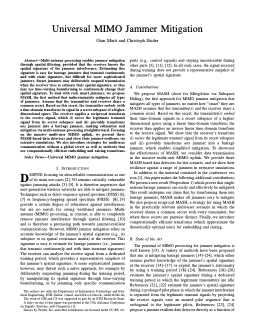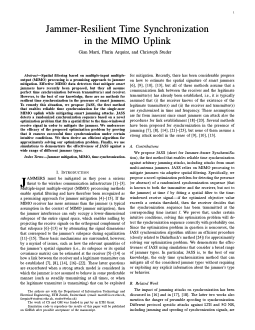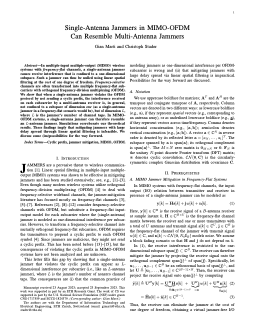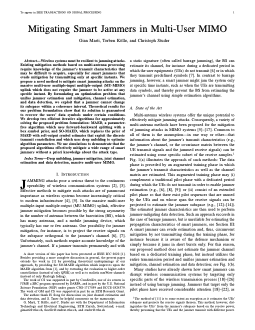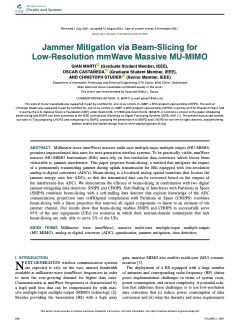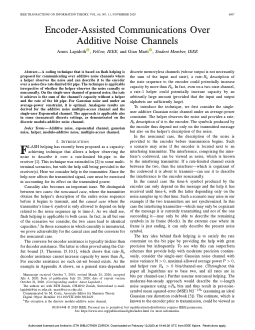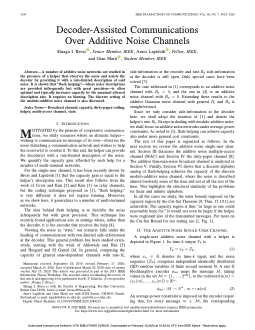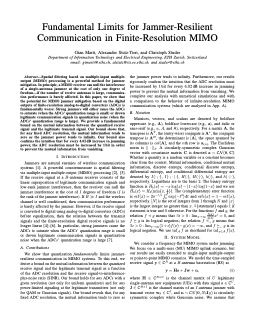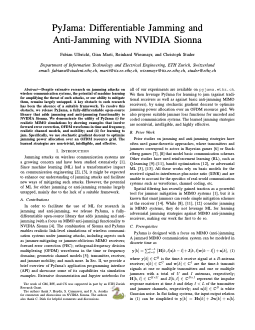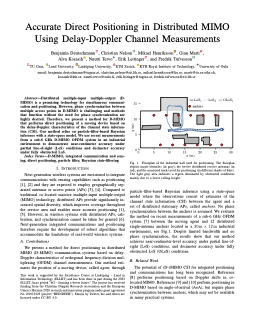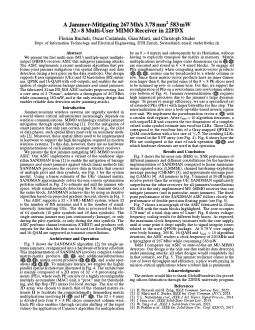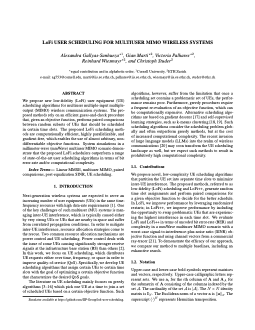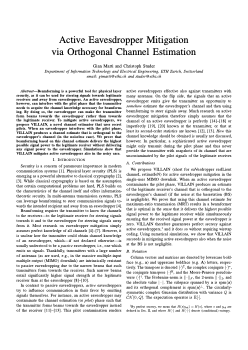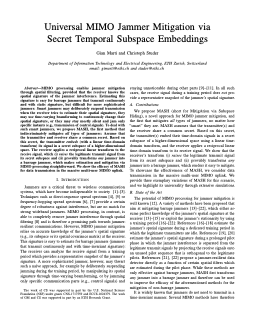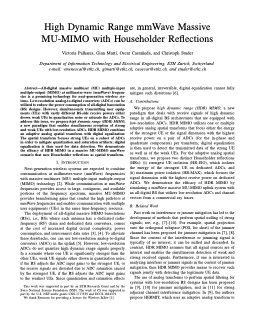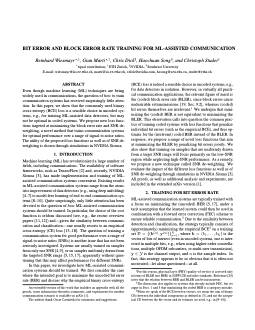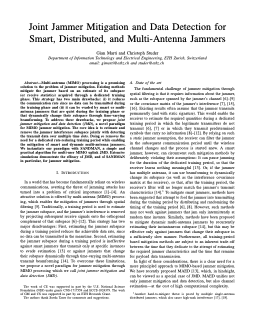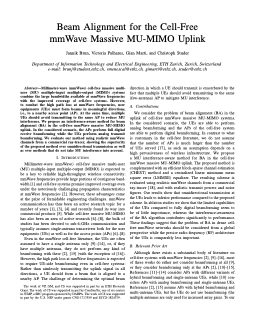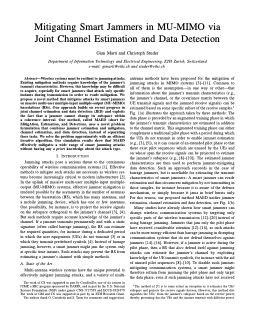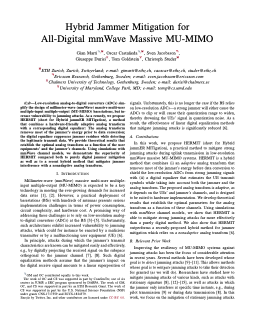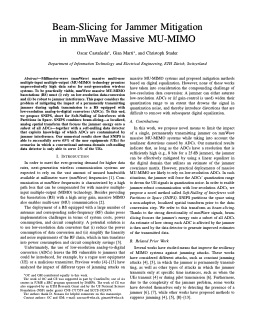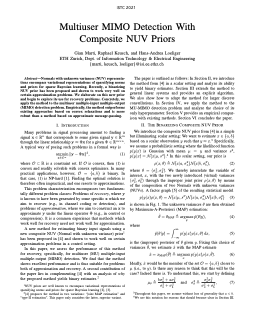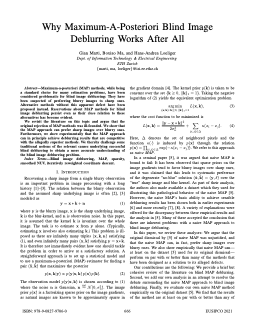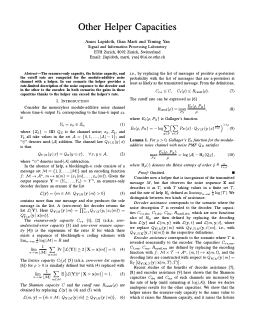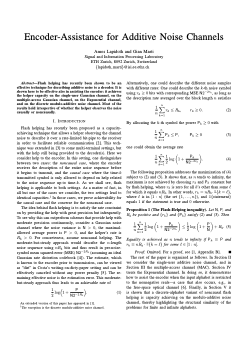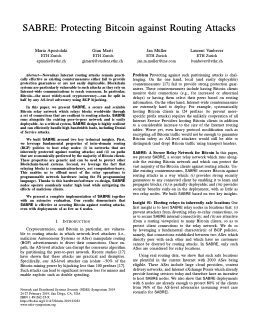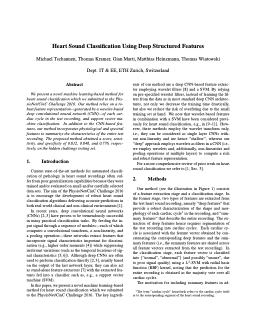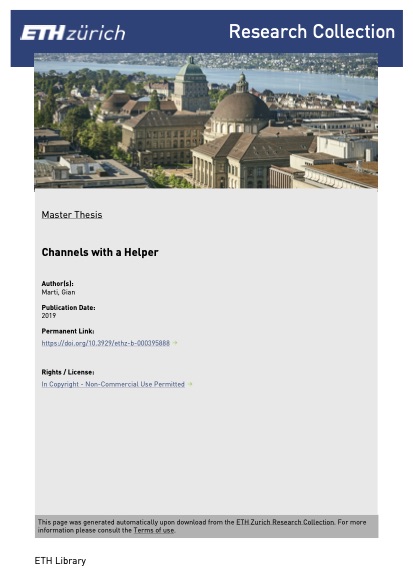Publications
Journal Papers
Multi-antenna processing enables jammer mitigation through spatial filtering, provided that the receiver knows the spatial signature of the jammer interference. Estimating this signature is easy for barrage jammers that transmit continuously and with static signature, but difficult for more sophisticated jammers. Smart jammers may deliberately suspend transmission when the receiver tries to estimate their spatial signature, or they may use time-varying beamforming to continuously change their spatial signature. To deal with such smart jammers, we propose MASH, the first method that indiscriminately mitigates all types of jammers. Assume that the transmitter and receiver share a common secret. Based on this secret, the transmitter embeds (with a time-domain transform) its signal in a secret subspace of a higher-dimensional space. The receiver applies a reciprocal transform to the receive signal, which (i) raises the legitimate transmit signal from its secret subspace and (ii) provably transforms any jammer into a barrage jammer, making estimation and mitigation via multi-antenna processing straightforward. Focusing on the massive multi-user MIMO uplink, we present three MASH-based data detectors and show their jammer-resilience via extensive simulations. We also introduce strategies for multi-user communication without a global secret as well as methods that use computationally efficient embedding and raising transforms.
Spatial filtering based on multiple-input multiple-output (MIMO) processing is a promising approach to jammer mitigation. Effective MIMO data detectors that mitigate smart jammers have recently been proposed, but they all assume perfect time synchronization between transmitter(s) and receiver. However, to the best of our knowledge, there are no methods for resilient time synchronization in the presence of smart jammers. To remedy this situation, we propose JASS, the first method that enables reliable time synchronization for the single-user MIMO uplink while mitigating smart jamming attacks. JASS detects a randomized synchronization sequence based on a novel optimization problem that fits a spatial filter to the time-windowed receive signal in order to mitigate the jammer. We underscore the efficacy of the proposed optimization problem by proving that it ensures successful time synchronization under certain intuitive conditions. We then derive an efficient algorithm for approximately solving our optimization problem. Finally, we use simulations to demonstrate the effectiveness of JASS against a wide range of different jammer types.
In multiple-input multiple-output (MIMO) wireless systems with frequency-flat channels, a single-antenna jammer causes receive interference that is confined to a one-dimensional subspace. Such a jammer can thus be nulled using linear spatial filtering at the cost of one degree of freedom. Frequency-selective channels are often transformed into multiple frequency-flat subcarriers with orthogonal frequency-division multiplexing (OFDM). We show that when a single-antenna jammer violates the OFDM protocol by not sending a cyclic prefix, the interference received on each subcarrier by a multi-antenna receiver is, in general, not confined to a subspace of dimension one (as a single-antenna jammer in a frequency-flat scenario would be), but of dimension L, where L is the jammer's number of channel taps. In MIMO-OFDM systems, a single-antenna jammer can therefore resemble an L-antenna jammer. Simulations corroborate our theoretical results. These findings imply that mitigating jammers with large delay spread through linear spatial filtering is infeasible. We discuss some (im)possibilities for the way forward.
Wireless systems must be resilient to jamming attacks. Existing mitigation methods based on multi-antenna processing require knowledge of the jammer's transmit characteristics that may be difficult to acquire, especially for smart jammers that evade mitigation by transmitting only at specific instants. We propose a novel method to mitigate smart jamming attacks on the massive multi-user multiple-input multiple-output (MU-MIMO) uplink which does not require the jammer to be active at any specific instant. By formulating an optimization problem that unifies jammer estimation and mitigation, channel estimation, and data detection, we exploit that a jammer cannot change its subspace within a coherence interval. Theoretical results for our problem formulation show that its solution is guaranteed to recover the users' data symbols under certain conditions. We develop two efficient iterative algorithms for approximately solving the proposed problem formulation: MAED, a parameter-free algorithm which uses forward-backward splitting with a box symbol prior, and SO-MAED, which replaces the prior of MAED with soft-output symbol estimates that exploit the discrete transmit constellation and which uses deep unfolding to optimize algorithm parameters. We use simulations to demonstrate that the proposed algorithms effectively mitigate a wide range of smart jammers without a priori knowledge about the attack type.
Millimeter-wave (mmWave) massive multi-user multiple-input multiple-output (MU-MIMO) promises unprecedented data rates for next-generation wireless systems. To be practically viable, mmWave massive MU-MIMO basestations (BSs) must rely on low-resolution data converters which leaves them vulnerable to jammer interference. This paper proposes beam-slicing, a method that mitigates the impact of a permanently transmitting jammer during uplink transmission for BSs equipped with low-resolution analog-to-digital converters (ADCs). Beam-slicing is a localized analog spatial transform that focuses the jammer energy onto few ADCs, so that the transmitted data can be recovered based on the outputs of the interference-free ADCs. We demonstrate the efficacy of beam-slicing in combination with two digital jammer-mitigating data detectors: SNIPS and CHOPS. Soft-Nulling of Interferers with Partitions in Space (SNIPS) combines beam-slicing with a soft-nulling data detector that exploits knowledge of the ADC contamination; projeCtion onto ortHOgonal complement with Partitions in Space (CHOPS) combines beam-slicing with a linear projection that removes all signal components co-linear to an estimate of the jammer channel. Our results show that beam-slicing enables SNIPS and CHOPS to successfully serve 65% of the user equipments (UEs) for scenarios in which their antenna-domain counterparts that lack beam-slicing are only able to serve 2% of the UEs.
A coding technique that is based on flash helping is proposed for communicating over additive noise channels where a helper observes the noise and can describe it to the encoder over a noise-free rate-limited bit pipe. The technique is applicable irrespective of whether the helper observes the noise causally or noncausally. On the single-user channel of general noise, the rate it achieves is the sum of the channel’s capacity without a helper and the rate of the bit pipe. For Gaussian noise and under an average-power constraint, it is optimal. Analogous results are derived for the additive noise multiple-access channel and the single- user Exponential channel. The approach is applicable also in some (noncausal) discrete settings, as shown for the discrete modulo-additive noise channel.
A number of additive noise networks are studied in the presence of a helper that observes
the noise and assists the decoder by providing it with a rate-limited description of said noise.
It is shown that “flash helping”—where noise descriptions are provided infrequently but with
great precision—is often optimal and typically increases capacity by the maximal allowed
description rate. It requires no binning.
The discrete setting of the modulo-additive noise
channel is also discussed.
*These authors contributed equally.
†The authors are ordered alphabetically – the order does not indicate the amount of contribution.
Conference, Symposium, and Workshop Papers
Spatial filtering based on multiple-input multiple-output (MIMO) processing is a powerful method for jammer mitigation. In principle, a MIMO receiver can null the interference of a single-antenna jammer at the cost of only one degree of freedom - if the number of receive antennas is large, communication performance is barely affected. In this paper, we show that the potential for MIMO jammer mitigation based on the digital outputs of finite-resolution analog-to-digital converters (ADCs) is fundamentally worse: Strong jammers will either cause the ADCs to saturate (when the ADCs' quantization range is small) or drown legitimate communication signals in quantization noise (when the ADCs' quantization range is large). We provide a fundamental bound on the mutual information between the quantized receive signal and the legitimate transmit signal. Our bound shows that, for any fixed ADC resolution, the mutual information tends to zero as the jammer power tends to infinity. Our bound also confirms the intuition that for every 6.02 dB increase in jamming power, the ADC resolution must be increased by 1 bit in order to prevent the mutual information from vanishing.
Despite extensive research on jamming attacks on wireless communication systems, the potential of machine learning for amplifying the threat of such attacks, or our ability to mitigate them, remains largely untapped. A key obstacle to such research has been the absence of a suitable framework. To resolve this obstacle, we release PyJama, a fully-differentiable open-source library that adds jamming and anti-jamming functionality to NVIDIA Sionna. We demonstrate the utility of PyJama (i) for realistic MIMO simulations by showing examples that involve forward error correction, OFDM waveforms in time and frequency, realistic channel models, and mobility; and (ii) for learning to jam. Specifically, we use stochastic gradient descent to optimize jamming power allocation over an OFDM resource grid. The learned strategies are non-trivial, intelligible, and effective.
Distributed multiple-input multiple-output (D-MIMO) is a promising technology for simultaneous communication and positioning. However, phase synchronization between multiple access points in D-MIMO is challenging, which requires methods that function without the need for phase synchronization. We therefore present a method for D-MIMO that performs direct positioning of a moving device based on the delay-Doppler characteristics of the channel state information (CSI). Our method relies on particle-filter-based Bayesian inference with a state-space model. We use recent measurements from a sub-6 GHz D-MIMO OFDM system in an industrial environment to demonstrate centimeter accuracy under partial line-of-sight (LoS) conditions and decimeter accuracy under full non-LoS.
We present the first multi-user (MU) multiple-input multiple-output (MIMO) receiver ASIC that mitigates jamming attacks. The ASIC implements a recent nonlinear algorithm that performs joint jammer mitigation (via spatial filtering) and data detection (using a box prior on the data symbols). Our design supports 8 user equipments (UEs) and 32 basestation (BS) antennas, QPSK and 16-QAM with soft-outputs, and enables the mitigation of single-antenna barrage jammers and smart jammers. The fabricated 22 nm FD-SOI ASIC includes preprocessing, has a core area of 3.78 mm2, achieves a throughput of 267 Mb/s while consuming 583 mW, and is the only existing design that enables reliable data detection under jamming attacks
We propose new low-fidelity (LoFi) user equipment (UE) scheduling algorithms for multiuser multiple-input multiple-output (MIMO) wireless communication systems. The proposed methods rely on an efficient guess-and-check procedure that, given an objective function, performs paired comparisons between random subsets of UEs that should be scheduled in certain time slots. The proposed LoFi scheduling methods are computationally efficient, highly parallelizable, and gradient-free, which enables the use of almost arbitrary, non-differentiable objective functions. System simulations in a millimeter-wave (mmWave) multiuser MIMO scenario demonstrate that the proposed LoFi schedulers outperform a range of state-of-the-art user scheduling algorithms in terms of bit error-rate and/or computational complexity.
Beamforming is a powerful tool for physical layer security, as it can be used for steering signals towards legitimate receivers and away from eavesdroppers. An active eavesdropper, however, can interfere with the pilot phase that the transmitter needs to acquire the channel knowledge necessary for beamforming. By doing so, the eavesdropper can make the transmitter form beams towards the eavesdropper rather than towards the legitimate receiver. To mitigate active eavesdroppers, we propose VILLAIN, a novel channel estimator that uses secret pilots. When an eavesdropper interferes with the pilot phase, VILLAIN produces a channel estimate that is orthogonal to the eavesdropper’s channel (in the noiseless case). We prove that beamforming based on this channel estimate delivers the highest possible signal power to the legitimate receiver without delivering any signal power to the eavesdropper. Simulations show that VILLAIN mitigates active eavesdroppers also in the noisy case.
MIMO processing enables jammer mitigation through spatial filtering, provided that the receiver knows the spatial signature of the jammer interference. Estimating this signature is easy for barrage jammers that transmit continuously and with static signature, but difficult for more sophisticated jammers: Smart jammers may deliberately suspend transmission when the receiver tries to estimate their spatial signature, they may use time-varying beamforming to continuously change their spatial signature, or they may stay mostly silent and jam only specific instants (e.g., transmission of control signals). To deal with such smart jammers, we propose MASH, the first method that indiscriminately mitigates all types of jammers: Assume that the transmitter and receiver share a common secret. Based on this secret, the transmitter embeds (with a linear time-domain transform) its signal in a secret subspace of a higher-dimensional space. The receiver applies a reciprocal linear transform to the receive signal, which (i) raises the legitimate transmit signal from its secret subspace and (ii) provably transforms any jammer into a barrage jammer, which makes estimation and mitigation via MIMO processing straightforward. We show the efficacy of MASH for data transmission in the massive multi-user MIMO uplink.
All-digital massive multiuser (MU) multiple-input multiple-output (MIMO) at millimeter-wave (mmWave) frequencies is a promising technology for next-generation wireless systems. Low-resolution analog-to-digital converters (ADCs) can be utilized to reduce the power consumption of all-digital basestation (BS) designs. However, simultaneously transmitting user equipments (UEs) with vastly different BS-side receive powers either drown weak UEs in quantization noise or saturate the ADCs. To address this issue, we propose high dynamic range (HDR) MIMO, a new paradigm that enables simultaneous reception of strong and weak UEs with low-resolution ADCs. HDR MIMO combines an adaptive analog spatial transform with digital equalization: The spatial transform focuses strong UEs on a subset of ADCs in order to mitigate quantization and saturation artifacts; digital equalization is then used for data detection. We demonstrate the efficacy of HDR MIMO in a massive MU-MIMO mmWave scenario that uses Householder reflections as spatial transform.
Even though machine learning (ML) techniques are being widely used in communications, the question of how to train communication systems has received surprisingly little attention. In this paper, we show that the commonly used binary cross-entropy (BCE) loss is a sensible choice in uncoded systems, e.g., for training ML-assisted data detectors, but may not be optimal in coded systems. We propose new loss functions targeted at minimizing the block error rate and SNR de-weighting, a novel method that trains communication systems for optimal performance over a range of signal-to-noise ratios. The utility of the proposed loss functions as well as of SNR de-weighting is shown through simulations in NVIDIA Sionna.
Multi-antenna (MIMO) processing is a promising solution to the problem of jammer mitigation. Existing methods mitigate the jammer based on an estimate of its subspace (or receive statistics) acquired through a dedicated training phase. This strategy has two main drawbacks: (i) it reduces the communication rate since no data can be transmitted during the training phase and (ii) it can be evaded by smart or multi-antenna jammers that are quiet during the training phase or that dynamically change their subspace through time-varying beamforming. To address these drawbacks, we propose Joint jammer Mitigation and data Detection (JMD), a novel paradigm for MIMO jammer mitigation. The core idea is to estimate and remove the jammer interference subspace jointly with detecting the transmit data over multiple time slots. Doing so removes the need for a dedicated and rate-reducing training period while mitigating smart and dynamic multi-antenna jammers. We instantiate our paradigm with SANDMAN, a simple and practical algorithm for multi-user MIMO uplink JMD. Extensive simulations demonstrate the efficacy of JMD, and of SANDMAN in particular, for jammer mitigation.
Millimeter-wave (mmWave) cell-free massive multi-user (MU) multiple-input multiple-output (MIMO) systems combine the large bandwidths available at mmWave frequencies with the improved coverage of cell-free systems. However, to combat the high path loss at mmWave frequencies, user equipments (UEs) must form beams in meaningful directions, i.e., to a nearby access point (AP). At the same time, multiple UEs should avoid transmitting to the same AP to reduce MU interference. We propose an interference-aware method for beam alignment (BA) in the cell-free mmWave massive MU-MIMO uplink. In the considered scenario, the APs perform full digital receive beamforming while the UEs perform analog transmit beamforming. We evaluate our method using realistic mmWave channels from a commercial ray-tracer, showing the superiority of the proposed method over omnidirectional transmission as well as over methods that do not take MU interference into account.
Wireless systems must be resilient to jamming attacks. Existing mitigation methods require knowledge of the jammer’s transmit characteristics. However, this knowledge may be difficult to acquire, especially for smart jammers that attack only specific instants during transmission in order to evade mitigation. We propose a novel method that mitigates attacks by smart jammers on massive multi-user multiple-input multiple-output (MU-MIMO) basestations (BSs). Our approach builds on recent progress in joint channel estimation and data detection (JED) and exploits the fact that a jammer cannot change its subspace within a coherence interval. Our method, called MAED (short for MitigAtion, Estimation, and Detection), uses a novel problem formulation that combines jammer estimation and mitigation, channel estimation, and data detection, instead of separating these tasks. We solve the problem approximately with an efficient iterative algorithm. Our simulation results show that MAED effectively mitigates a wide range of smart jamming attacks without having any a priori knowledge about the attack type.
Low-resolution analog-to-digital converters (ADCs) simplify the design of millimeter-wave (mmWave) massive multi-user multiple-input multiple-output (MU-MIMO) basestations, but increase vulnerability to jamming attacks. As a remedy, we propose HERMIT (short for Hybrid jammER MITigation), a method that combines a hardware-friendly adaptive analog transform with a corresponding digital equalizer: The analog transform removes most of the jammer’s energy prior to data conversion; the digital equalizer suppresses jammer residues while detecting the legitimate transmit data. We provide theoretical results that establish the optimal analog transform as a function of the user equipments’ and the jammer’s channels. Using simulations with mmWave channel models, we demonstrate the superiority of HERMIT compared both to purely digital jammer mitigation as well as to a recent hybrid method that mitigates jammer interference with a nonadaptive analog transform.
Millimeter-wave (mmWave) massive multi-user multiple-input multiple-output (MU-MIMO) technology promises unprecedentedly high data rates for next-generation wireless systems. To be practically viable, mmWave massive MU-MIMO basestations (BS) must (i) rely on low-resolution data-conversion and (ii) be robust to jammer interference. This paper considers the problem of mitigating the impact of a permanently transmitting jammer during uplink transmission to a BS equipped with low-resolution analog-to-digital converters (ADCs). To this end, we propose SNIPS, short for Soft-Nulling of Interferers with Partitions in Space. SNIPS combines beam-slicing---a localized, analog spatial transform that focuses the jammer energy onto a subset of all ADCs---together with a soft-nulling data detector that exploits knowledge of which ADCs are contaminated by jammer interference. Our numerical results show that SNIPS is able to successfully serve 65% of the user equipments (UEs) for scenarios in which a conventional antenna-domain soft-nulling data detector is only able to serve 2% of the UEs.
Normals with unknown variances (NUV) representations encompass variational representations of sparsifying norms and priors for sparse Bayesian learning. Recently, a binarizing NUV prior has been proposed and shown to work very well on certain approximation problems. We elaborate on this new prior and begin to explore its use for recovery problems. Concretely, we apply the method to the multiuser multiple-input multiple-output (MIMO) detection problem. Empirically, the method outperforms existing approaches based on convex relaxations and is more robust than a method based on approximate message-passing.
Maximum-a-posteriori (MAP) methods, while being a standard choice for many estimation problems, have been considered problematic for blind image deblurring: They have been suspected of preferring blurry images to sharp ones. Alternative methods without this apparent defect have been proposed instead. Reservations about MAP methods for blind image deblurring persist even as their close relation to these alternatives has become evident.
We revisit the literature on this topic and argue that the original rejection of MAP methods was ill-founded. We show that the MAP approach can prefer sharp images over blurry ones. Furthermore, we show experimentally that the MAP approach can in principle achieve deblurring results that are competitive with the allegedly superior methods. We thereby challenge some traditional notions of the relevant causes underlying successful blind deblurring to obtain a more accurate understanding of the blind image deblurring problem.
The erasures-only capacity, the listsize capacity, and the cutoff rate are computed for the modulo-additive noise channel with a helper. In one scenario the helper provides a rate-limited description of the noise sequence to the decoder and in the other to the encoder. In both scenarios the gains in these capacities thanks to the helper can exceed the helper’s rate.
Flash helping has recently been shown to be an effective technique for describing additive noise to a decoder. It is shown here to be effective also in assisting the encoder: it achieves the helper capacity on the single-user Gaussian channel, on the multiple-access Gaussian channel, on the Exponential channel, and on the discrete modulo-additive noise channel. Most of the results hold irrespective of whether the helper observes the noise causally or noncausally.
Nowadays Internet routing attacks remain practically effective as existing countermeasures either fail to provide
protection guarantees or are not easily deployable. Blockchain
systems are particularly vulnerable to such attacks as they rely on
Internet-wide communications to reach consensus. In particular,
Bitcoin—the most widely-used cryptocurrency—can be split in
half by any AS-level adversary using BGP hijacking. In this paper, we present SABRE, a secure and scalable
Bitcoin relay network which relays blocks worldwide through
a set of connections that are resilient to routing attacks. SABRE
runs alongside the existing peer-to-peer network and is easily
deployable. As a critical system, SABRE design is highly resilient
and can efficiently handle high bandwidth loads, including Denial
of Service attacks. We built SABRE around two key technical insights. First,
we leverage fundamental properties of inter-domain routing
(BGP) policies to host relay nodes: (i) in networks that are
inherently protected against routing attacks; and (ii) on paths
that are economically-preferred by the majority of Bitcoin clients.
These properties are generic and can be used to protect other
Blockchain-based systems. Second, we leverage the fact that
relaying blocks is communication-heavy, not computation-heavy.
This enables us to offload most of the relay operations to
programmable network hardware (using the P4 programming
language). Thanks to this hardware/software co-design, SABRE
nodes operate seamlessly under high load while mitigating the
effects of malicious clients. We present a complete implementation of SABRE together
with an extensive evaluation. Our results demonstrate that
SABRE is effective at securing Bitcoin against routing attacks,
even with deployments of as few as 6 nodes.
We present a novel machine learning-based method for heart sound classification which we submitted to the PhysioNet/CinC Challenge 2016. Our method relies on a robust feature representation - generated by a wavelet-based deep convolutional neural network (CNN) - of each cardiac cycle in the test recording, and support vector machine classification. In addition to the CNN-based features, our method incorporates physiological and spectral features to summarize the characteristics of the entire test recording. The proposed method obtained a score, sensitivity, and specificity of 0.812, 0.848, and 0.776, respectively, on the hidden challenge testing set.
Theses
- Abstract
- Report
- BibTeX
This thesis studies (multiuser) communication channels where rate-limited side information is non-causally made available to the decoder(s) or the encoder(s), or both, through a helper. The considered channels are either additive-noise channels, Y=x+Z, where the helper is aware of the noise Z, or they are additive-noise additive-state channels, Y=x+S+Z, where the helper is cognizant of the state S but not the noise Z.
It is known that for a single-user additive-noise channel, the presence of a helper at the decoder increases capacity by the rate of help, regardless of the noise distribution. In this thesis, it is shown that analogous results hold for various multiuser channels as well as for channels where help is available at the encoder, or at the encoder and the decoder. An equivalent achievability result is given even for a case where help is available at the encoder only causally. If help is available at the encoder, however, the question whether an increase in capacity by the rate of help represents the optimum is in general left open—such a converse is provided only for discrete channels as well as for the Gaussian additive-noise channel. All achievability results for these additive-noise channels are attained by a technique which we call flash-helping, where the noise is described very accurately at some time and not described at other times.
For several channels with two sources of additive interference—noise and state—of which the helper observes only one (the state), capacity bounds are provided. It is also shown that for these channels, the increase in capacity caused by the helper remains bounded away from the rate of help.
← home
